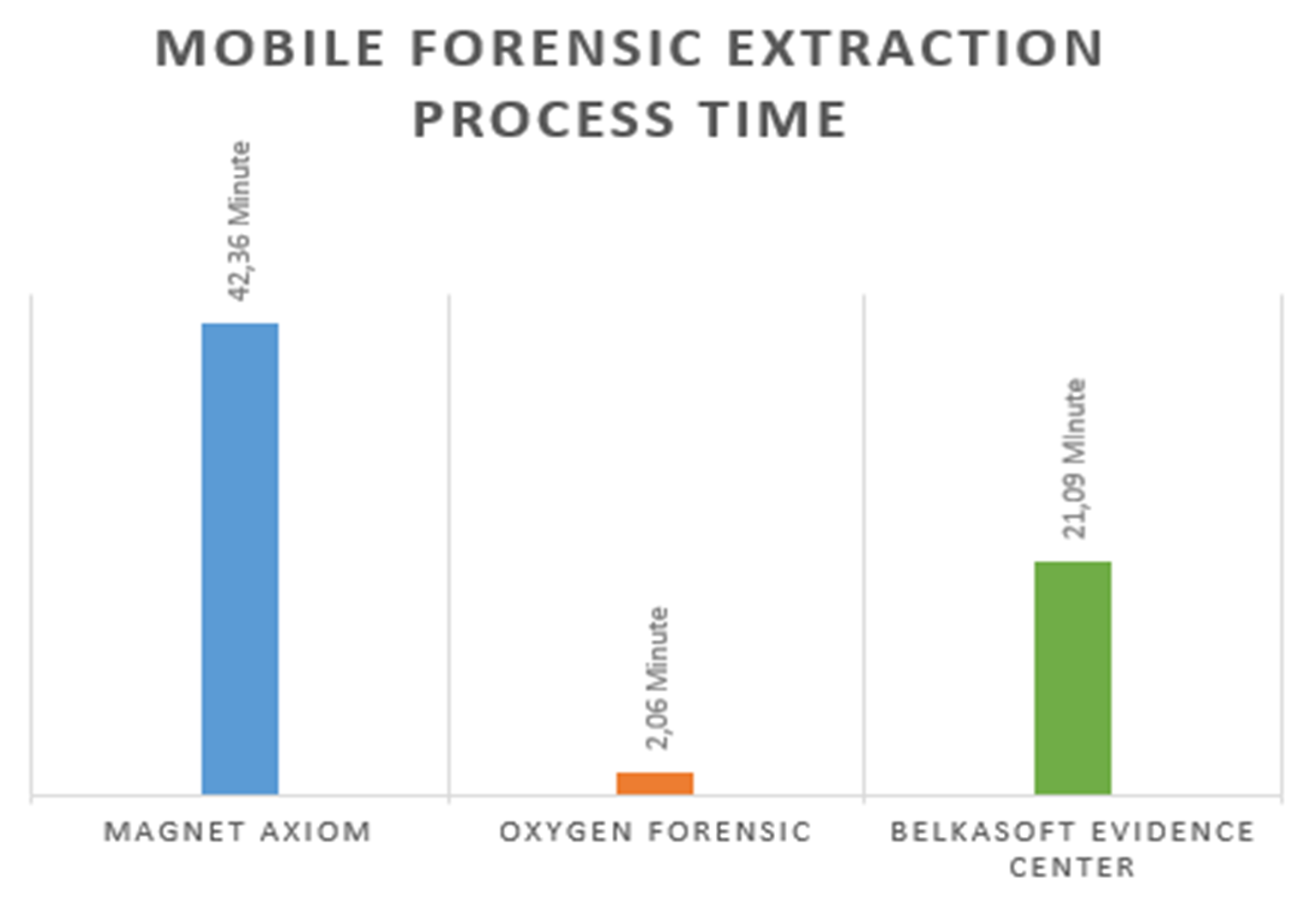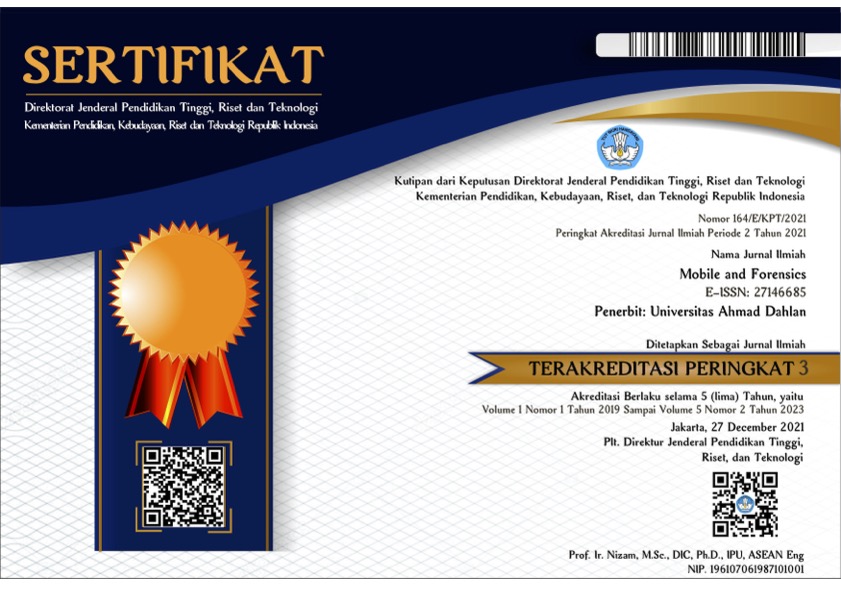Comparison of Forensic Tool Results on Android Smartphone Backup Files Using NIST Method
DOI:
https://doi.org/10.12928/mf.v4i2.6496Keywords:
Mobile Forensic Tools, Smartphone, Android Backup, NISTAbstract
Smartphone technology currently developing not only has a positive impact but can also have a negative impact if it is used to commit crimes which can be called cybercrime. Choosing the right forensic tools is very important when conducting an investigation. So it is necessary to research the results of the comparative analysis of the performance of forensic tools on android smartphone backup files. The National Institute of Standards and Technology (NIST) method was used in this study as a parameter and for the digital evidence obtained. The results of the extraction of the OPPO A37f android smartphone from the MOBILedit tools acquired android backup files and the analysis results from using the Magnet AXIOM tools with a data accuracy rate of 39.3% from the predetermined variables. The Oxygen Forensic Tools obtained a data accuracy rate of 28.6% from the variable that has been determined. The Belkasoft Evidence Center tools can get a data accuracy rate of 35.7% of the predetermined variables. The results of this study can be concluded that the Magnet Axiom tool has a high level of accuracy compared to the Oxygen Forensic and Belkasoft Evidence Center tools in extracting data from android smartphone backup files.
References
Statcounter, “Mobile Operating System Market Share Indonesia,” 2022. https://gs.statcounter.com/os-market-share/mobile/indonesia
I. Riadi, P. Studi Magister Teknik Informatika, and U. S. Ahmad Dahlan Yogyakarta Jl Soepomo Janturan, “Data Recovery Dengan Keamanan Fingerprint Pada Smartphone Android,” Semantikom.Unira.Ac.Id, 2018.
I. Z. Yadi and Y. N. Kunang, “Forensik Pada Platform Android,” Konf. Nas. Ilmu Komput., pp. 141–148, 2014.
I. Riadi, A. Yudhana, and M. C. F. Putra, “Forensic Tool Comparison on Instagram Digital Evidence Based on Android with The NIST Method,” Sci. J. Informatics, vol. 5, no. 2, pp. 235–247, 2018, doi: 10.15294/sji.v5i2.16545.
A. ahmadi, T. Akbar, H. M. Putra, “Perbandingan Hasil Tool Forensik Pada File Image Smartphone Android Menggunakan Metode Nist,” JIKO (Jurnal Inform. dan Komputer), vol. 4, no. 2, pp. 92–97, 2021, doi: 10.33387/jiko.v4i2.2812.
Fileinfo.com, “AB File Extension,” 2022.
K. Kent, S. Chevalier, T. Grance, and H. Dang, “Guide to Integrating Forensic Techniques into Incident Response,” Natl. Inst. Stand. Technol., 2006.
NIST, “Mobile Device Forensic Tool Specification , Test Assertions and Test Cases,” no. May, pp. 1–18, 2019, [Online]. Available: https://www.nist.gov/system/files/documents/2019/07/11/mobile_device_forensic_tool_test_spec_v_3.0.pdf
R. Rahmansyah, “Perbandingan Hasil Investigasi Barang Bukti Digital Pada Aplikasi Facebook Dan Instagram Dengan Metode Nist,” Cyber Secur. dan Forensik Digit., vol. 4, no. 1, pp. 49–57, 2021, doi: 10.14421/csecurity.2021.4.1.2421.
I. Riadi, R. Umar, and A. Firdonsyah, “Forensic tools performance analysis on android-based blackberry messenger using NIST measurements,” Int. J. Electr. Comput. Eng., vol. 8, no. 5, pp. 3991–4003, 2018, doi: 10.11591/ijece.v8i5.pp3991-4003.

Downloads
Published
Issue
Section
License
Copyright (c) 2022 Permana Bangun Pangestu, Muhammad Koprawi

This work is licensed under a Creative Commons Attribution-ShareAlike 4.0 International License.
Start from 2019 issues, authors who publish with JURNAL MOBILE AND FORENSICS agree to the following terms:
- Authors retain copyright and grant the journal right of first publication with the work simultaneously licensed under a Creative Commons Attribution License (CC BY-SA 4.0) that allows others to share the work with an acknowledgment of the work's authorship and initial publication in this journal.
- Authors are able to enter into separate, additional contractual arrangements for the non-exclusive distribution of the journal's published version of the work (e.g., post it to an institutional repository or publish it in a book), with an acknowledgment of its initial publication in this journal.
- Authors are permitted and encouraged to post their work online (e.g., in institutional repositories or on their website) prior to and during the submission process, as it can lead to productive exchanges, as well as earlier and greater citation of published work.

This work is licensed under a Creative Commons Attribution-ShareAlike 4.0 International License.











 Mobile and Forensics (MF)
Mobile and Forensics (MF)